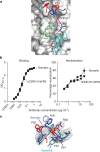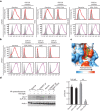Structural and genetic basis for development of broadly neutralizing influenza antibodies - PubMed (original) (raw)
. 2012 Sep 27;489(7417):566-70.
doi: 10.1038/nature11371. Epub 2012 Aug 29.
Affiliations
- PMID: 22932267
- PMCID: PMC7095019
- DOI: 10.1038/nature11371
Structural and genetic basis for development of broadly neutralizing influenza antibodies
Daniel Lingwood et al. Nature. 2012.
Abstract
Influenza viruses take a yearly toll on human life despite efforts to contain them with seasonal vaccines. These viruses evade human immunity through the evolution of variants that resist neutralization. The identification of antibodies that recognize invariant structures on the influenza haemagglutinin (HA) protein have invigorated efforts to develop universal influenza vaccines. Specifically, antibodies to the highly conserved stem region of HA neutralize diverse viral subtypes. These antibodies largely derive from a specific antibody gene, heavy-chain variable region IGHV1-69, after limited affinity maturation from their germline ancestors, but how HA stimulates naive B cells to mature and induce protective immunity is unknown. To address this question, we analysed the structural and genetic basis for their engagement and maturation into broadly neutralizing antibodies. Here we show that the germline-encoded precursors of these antibodies act as functional B-cell antigen receptors (BCRs) that initiate subsequent affinity maturation. Neither the germline precursor of a prototypic antibody, CR6261 (ref. 3), nor those of two other natural human IGHV1-69 antibodies, bound HA as soluble immunoglobulin-G (IgG). However, all three IGHV1-69 precursors engaged HA when the antibody was expressed as cell surface IgM. HA triggered BCR-associated tyrosine kinase signalling by germline transmembrane IgM. Recognition and virus neutralization was dependent solely on the heavy chain, and affinity maturation of CR6261 required only seven amino acids in the complementarity-determining region (CDR) H1 and framework region 3 (FR3) to restore full activity. These findings provide insight into the initial events that lead to the generation of broadly neutralizing antibodies to influenza, informing the rational design of vaccines to elicit such antibodies and providing a model relevant to other infectious diseases, including human immunodeficiency virus/AIDS. The data further suggest that selected immunoglobulin genes recognize specific protein structural 'patterns' that provide a substrate for further affinity maturation.
Conflict of interest statement
The authors declare no competing financial interests.
Figures
Figure 1. Somatic maturation of heavy chain confers HA reactivity.
a, Amino acid alignment of somatic CR6261 heavy-chain variable region (including the D and J regions) with JOINSOLVER predicted germline precursor (Kabat convention). Somatic mutations are shown in red. Those incorporated into germline variants are underlined. Mutations T28P and S30R are in close proximity to the Kabat-defined CDR H1 and are CR6261 contact residues, and therefore defined as CDR H1 somatic mutations in the remaining text. b, ELISA binding of somatic (sHsL, filled circles), respective germline (gHgL, open circles), and chimaeric (sHgL, half-filled circles) indicated HA-stem-specific antibodies to H1 1999 NC. OD, optical density. Error bars represent standard deviations of the mean for each antibody concentration. PowerPoint slide
Figure 2. CDR H1 maturation confers CR6261 neutralization activity.
a, CR6261 interaction with H1 A/South Carolina/1/1918 (1918 SC) HA stem (grey, PDB accession 3GBN). Side chains with at least 10 Å2 of interaction are depicted as sticks, with somatically mutated residues coloured red. b, ELISA binding and neutralization of H1 1999 NC by mature (filled circles) and sCDR H1/sFR3 germline-mutated CR6261 (filled squares) Error bars represent standard deviations of the mean for each antibody concentration. c, CDR H1 of CR6261 uncomplexed (blue) or with HA (light blue, PDB accession 3GBN) compared with unmutated CDR H1 from 47e (cyan, PDB accession 1RZI); mutated residues are in red (CR6261) or pink (47e). A non-crystallographic symmetry (NCS)-averaged electron density map (grey) is contoured at 1.0_σ_. PowerPoint slide
Figure 3. HA engages and activates membrane-presented germline antibody.
a, 293F cells expressing membrane IgMs (VRC01 (grey), IGHV1-69 germ lines (wild-type and Ile53Ala/Phe54Ala mutants, coloured lines)) exposed to HA with an N-linked glycan introduced to block the sialic-acid-binding site (ΔRBS) (red) and anti-light-chain expression controls (purple) analysed by flow cytometry. b, Unmodified HA trimer also engages germline (30 mM 6′-sialyllactose present) by flow cytometry. c, CR6261 CDR H2 interactions with 1918 SC HA stem (PDB accession 3GBN). d, HA proteoliposomes selectively activate tyrosine phosphorylation (pY) by CR6261 germline BCR (P < 0.0002, ANOVA); wild-type and mutant CDR H2 receptor activity differed for HA (asterisk) but not for anti-IgM (Tukey’s HSD, α = 0.05)). Presented are the mean values and standard errors of pY intensity. PowerPoint slide
Similar articles
- Convergent Evolution in Breadth of Two VH6-1-Encoded Influenza Antibody Clonotypes from a Single Donor.
Wu NC, Andrews SF, Raab JE, O'Connell S, Schramm CA, Ding X, Chambers MJ, Leung K, Wang L, Zhang Y, Mascola JR, Douek DC, Ledgerwood JE, McDermott AB, Wilson IA. Wu NC, et al. Cell Host Microbe. 2020 Sep 9;28(3):434-444.e4. doi: 10.1016/j.chom.2020.06.003. Epub 2020 Jul 2. Cell Host Microbe. 2020. PMID: 32619441 Free PMC article. - Flow cytometry reveals that H5N1 vaccination elicits cross-reactive stem-directed antibodies from multiple Ig heavy-chain lineages.
Whittle JR, Wheatley AK, Wu L, Lingwood D, Kanekiyo M, Ma SS, Narpala SR, Yassine HM, Frank GM, Yewdell JW, Ledgerwood JE, Wei CJ, McDermott AB, Graham BS, Koup RA, Nabel GJ. Whittle JR, et al. J Virol. 2014 Apr;88(8):4047-57. doi: 10.1128/JVI.03422-13. Epub 2014 Feb 5. J Virol. 2014. PMID: 24501410 Free PMC article. - Structural Determination of the Broadly Reactive Anti-IGHV1-69 Anti-idiotypic Antibody G6 and Its Idiotope.
Avnir Y, Prachanronarong KL, Zhang Z, Hou S, Peterson EC, Sui J, Zayed H, Kurella VB, McGuire AT, Stamatatos L, Hilbert BJ, Bohn MF, Kowalik TF, Jensen JD, Finberg RW, Wang JP, Goodall M, Jefferis R, Zhu Q, Kurt Yilmaz N, Schiffer CA, Marasco WA. Avnir Y, et al. Cell Rep. 2017 Dec 12;21(11):3243-3255. doi: 10.1016/j.celrep.2017.11.056. Cell Rep. 2017. PMID: 29241550 Free PMC article. - Broadly neutralizing antibodies against influenza viruses.
Laursen NS, Wilson IA. Laursen NS, et al. Antiviral Res. 2013 Jun;98(3):476-83. doi: 10.1016/j.antiviral.2013.03.021. Epub 2013 Apr 9. Antiviral Res. 2013. PMID: 23583287 Free PMC article. Review. - Influenza Hemagglutinin Structures and Antibody Recognition.
Wu NC, Wilson IA. Wu NC, et al. Cold Spring Harb Perspect Med. 2020 Aug 3;10(8):a038778. doi: 10.1101/cshperspect.a038778. Cold Spring Harb Perspect Med. 2020. PMID: 31871236 Free PMC article. Review.
Cited by
- Recognition of membrane-bound fusion-peptide/MPER complexes by the HIV-1 neutralizing 2F5 antibody: implications for anti-2F5 immunogenicity.
Huarte N, Araujo A, Arranz R, Lorizate M, Quendler H, Kunert R, Valpuesta JM, Nieva JL. Huarte N, et al. PLoS One. 2012;7(12):e52740. doi: 10.1371/journal.pone.0052740. Epub 2012 Dec 21. PLoS One. 2012. PMID: 23285173 Free PMC article. - Germinal Center B Cell Dynamics.
Mesin L, Ersching J, Victora GD. Mesin L, et al. Immunity. 2016 Sep 20;45(3):471-482. doi: 10.1016/j.immuni.2016.09.001. Immunity. 2016. PMID: 27653600 Free PMC article. Review. - H5N1 Vaccine-Elicited Memory B Cells Are Genetically Constrained by the IGHV Locus in the Recognition of a Neutralizing Epitope in the Hemagglutinin Stem.
Wheatley AK, Whittle JR, Lingwood D, Kanekiyo M, Yassine HM, Ma SS, Narpala SR, Prabhakaran MS, Matus-Nicodemos RA, Bailer RT, Nabel GJ, Graham BS, Ledgerwood JE, Koup RA, McDermott AB. Wheatley AK, et al. J Immunol. 2015 Jul 15;195(2):602-10. doi: 10.4049/jimmunol.1402835. Epub 2015 Jun 15. J Immunol. 2015. PMID: 26078272 Free PMC article. Clinical Trial. - An integrated technology for quantitative wide mutational scanning of human antibody Fab libraries.
Petersen BM, Kirby MB, Chrispens KM, Irvin OM, Strawn IK, Haas CM, Walker AM, Baumer ZT, Ulmer SA, Ayala E, Rhodes ER, Guthmiller JJ, Steiner PJ, Whitehead TA. Petersen BM, et al. bioRxiv [Preprint]. 2024 Jan 16:2024.01.16.575852. doi: 10.1101/2024.01.16.575852. bioRxiv. 2024. PMID: 38293170 Free PMC article. Updated. Preprint. - High-Throughput Mapping of B Cell Receptor Sequences to Antigen Specificity.
Setliff I, Shiakolas AR, Pilewski KA, Murji AA, Mapengo RE, Janowska K, Richardson S, Oosthuysen C, Raju N, Ronsard L, Kanekiyo M, Qin JS, Kramer KJ, Greenplate AR, McDonnell WJ, Graham BS, Connors M, Lingwood D, Acharya P, Morris L, Georgiev IS. Setliff I, et al. Cell. 2019 Dec 12;179(7):1636-1646.e15. doi: 10.1016/j.cell.2019.11.003. Epub 2019 Nov 28. Cell. 2019. PMID: 31787378 Free PMC article.
References
Publication types
MeSH terms
Substances
LinkOut - more resources
Full Text Sources
Other Literature Sources


